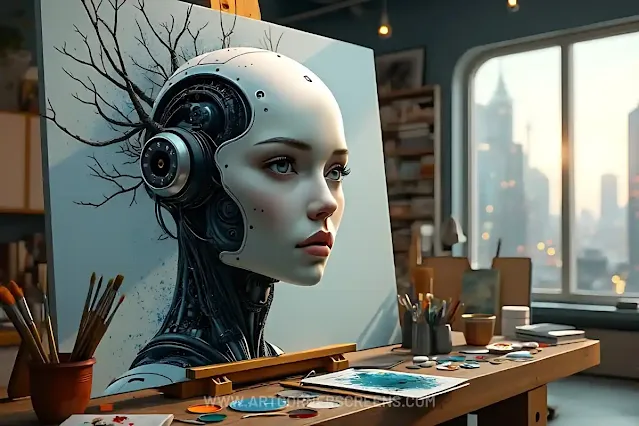 |
| AI Chatbots Transforming Art |
AI Chatbots Transforming Art
Realism in art has always been about truthfully capturing the world around us. From the detailed landscapes of 19th-century masters to the photo-like portraits of modern times, realism aims to reflect life as it is. However, in today's digital age, realism is dramatically transforming, thanks to artificial intelligence (AI).
Tools like OpenAI's ChatGPT-4 and platforms like MidJourney reshape the artistic process, enabling creators to blend human ingenuity with machine precision. These innovations are not just tools—they are partners in the evolution of art.
The Role of AI in Transforming Realism
How AI Chatbots Are Revolutionizing Creativity, AI chatbots like OpenAI's ChatGPT-4 have redefined how artists approach their craft. Initially designed for natural language processing, ChatGPT-4 nisan is essential for artists seeking inspiration, conceptual clarity, and creative collaboration. By providing detailed responses to prompts, offering historical or cultural context, and even brainstorming unique ideas, ChatGPT-4 helps artists refine their visions.
Platforms like MidJourney complement this process by turning textual prompts into vivid, hyper-realistic visual outputs. For example, an artist can describe a scene—a sunset over a futuristic city—and MidJourney can generate a detailed, lifelike depiction in seconds. This ability to bridge words and visuals opens up new possibilities for realism, allowing artists to achieve previously painstakingly difficult or time-consuming results.
Realism Beyond Traditional Boundaries
Historically, realism has been grounded in human perception and manual techniques. With AI, the genre is expanding into new dimensions. By combining artistic intent with machine-driven precision, artists can now create works that are visually accurate and layered with conceptual depth. AI excels at handling intricate details like light, texture, and perspective, freeing artists to focus on storytelling and emotional resonance.
For instance, a project exploring realism in historical art might use ChatGPT-4 to provide insights into a specific era's clothing, architecture, and daily life. MidJourney can then render these details with stunning accuracy, creating authentic yet fresh images.
Democratizing Art Through Artificial Intelligence
Opening Doors for New Creators: AI-powered tools like ChatGPT-4 and MidJourney are making art more accessible than ever. Creating highly realistic artwork in the past required years of training and significant financial investment. Today, anyone with an idea and access to these tools can produce professional-quality art.
This democratization of creativity aligns perfectly with realism's historical ethos: making art that resonates with a broad audience. By lowering entry barriers, AI ensures that diverse voices and perspectives are represented in the evolving landscape of visual art.
Enhancing the Work of Established Artists
Even seasoned artists are finding new opportunities in AI. By automating labor-intensive tasks, these tools allow artists to experiment with styles and techniques they might not have explored otherwise. AI doesn't replace the artist's vision; it collaborates, enabling faster and more innovative workflows.
AI in Prestigious Art Institutions
The Museum of Modern Art's Embrace of AI Prominent institutions like The Museum of Modern Art (MoMA) are beginning to recognize the artistic potential of AI. Recent exhibitions have featured AI-generated works, sparking discussions about the intersection of technology and creativity. BMoMA highlights how AI influences realism and other genres by including these pieces alongside traditional art,
Shaping the Future of Visual Art
Incorporating AI-generated art into museum collections challenges conventional ideas about authorship and originality. This evolution is particularly significant for realism. AI tools like MidJourney produce works rival human-made art in detail and accuracy, prompting viewers to reconsider what constitutes "realistic" representation in a digital age.
Ethical and Philosophical Implications
Who Owns AI-Created Art? One of the most pressing questions in AI-generated art is authorship. Who owns the final product if a piece is created through collaboration with AI? The artist who conceptualized it? The platform that generated it? These concerns are especially pertinent in realism, where the artist's intent and skill have traditionally been central to the work's value.
Emotional Depth vs. Machine Precision
While AI can replicate visual details with remarkable accuracy, it lacks the emotional and experiential layers that inform human creativity. This raises philosophical questions about the nature of realism. Can AI genuinely capture the essence of life, or does it merely simulate it? These debates will shape the role of AI in art for years to come.
The Future of Realism: A Human-AI Collaboration
Expanding Creative Horizons The future of realism lies in the partnership between human artists and AI. Tools like OOpenAI's ChatGPT -4 and MidJourneyenhance traditional techniques redefine what is possible. By merging human imagination with machine learning, these technologies push realism beyond its historical boundaries, creating works as innovative as they are lifelike.
The Role of Institutions and Artists
Institutions like MoMA will play a crucial role in legitimizing and shaping this new era of art. By showcasing AI-generated works and fostering discussions about their impact, they help bridge the gap between traditional and digital artistry. Meanwhile, artists who embrace AI as a creative partner will expand the possibilities of realism. As realism evolves, the relationship between human creativity and artificial intelligence will become even more dynamic.
This post is part of the Art Online section of Art Corner Screens, where we explore how technology transforms the art world. Stay tuned for more insights into this exciting intersection of creativity and innovation!
